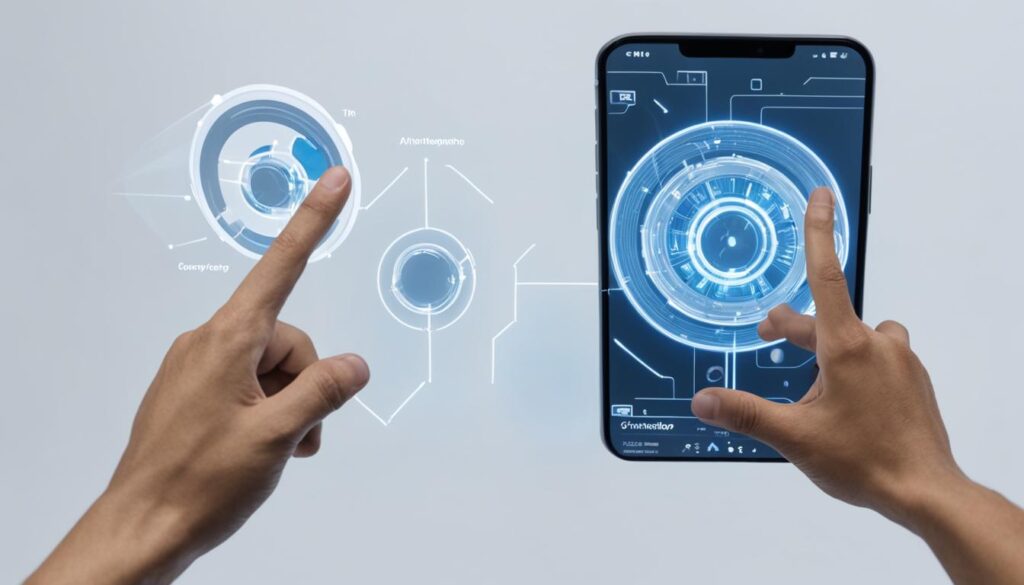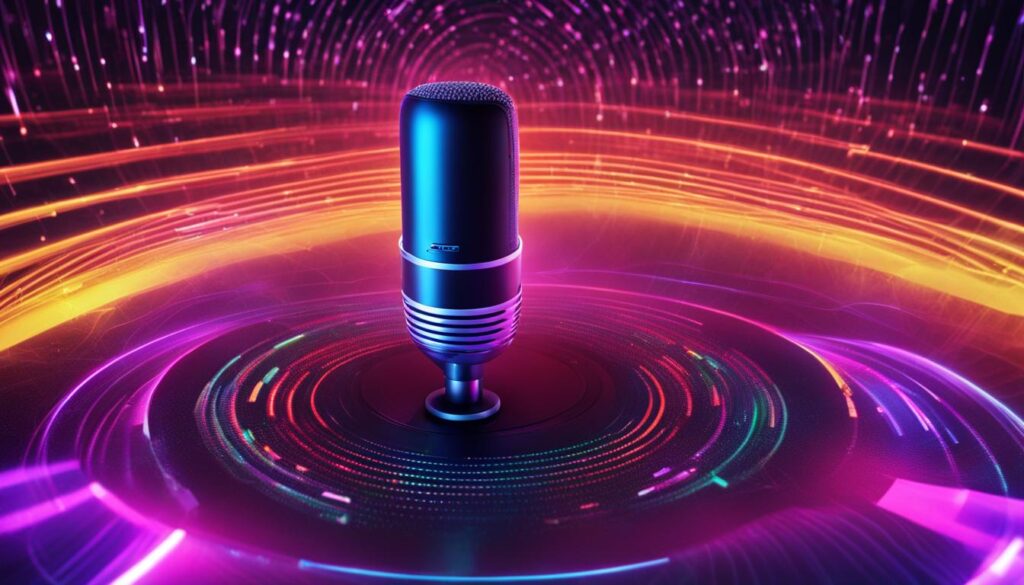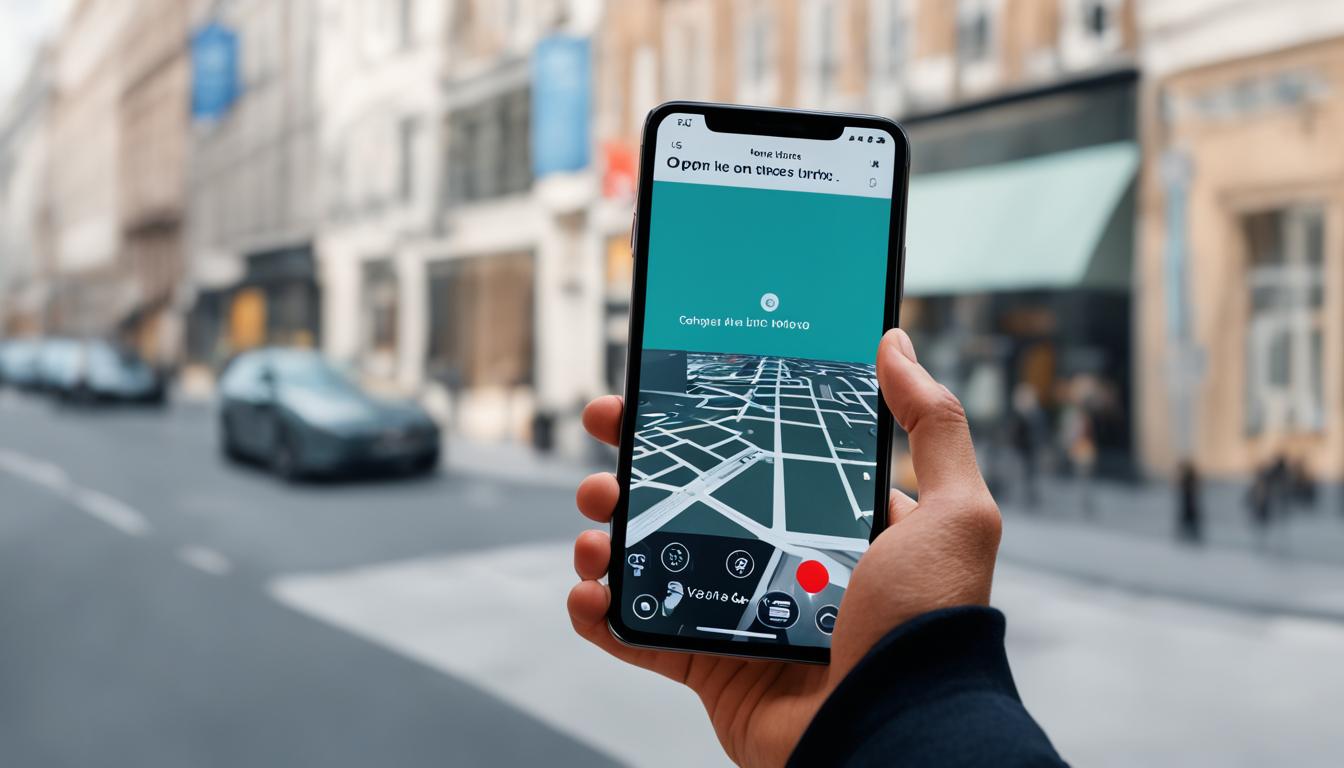Augmented reality (AR) is an exciting technology that enhances our real-world experience by overlaying digital information. But have you ever wondered how users input data in augmented reality? In this article, we will explore the various methods through which users can interact with AR and input data to make the virtual tangible.
AR opens up a world of possibilities for users to engage with virtual objects, navigate through AR environments, and manipulate digital elements in the real world. To achieve this, various input methods have been developed, ranging from sensors to cameras and even mind-controlled devices.
Contents
- 1 Understanding Augmented Reality
- 2 Input Mechanisms in Augmented Reality
- 3 Vision and Cameras as Input in Augmented Reality
- 4 Sounds and Microphones as Input in Augmented Reality
- 5 Conclusion
- 6 FAQ
- 6.1 How do users input data in augmented reality?
- 6.2 What is augmented reality?
- 6.3 How does augmented reality differ from virtual reality?
- 6.4 What are the input mechanisms in augmented reality?
- 6.5 How do vision and cameras play a role in user input in augmented reality?
- 6.6 How do sound and microphones contribute to input in augmented reality?
- 6.7 What does the future of user input in augmented reality look like?
- 7 Source Links
Key Takeaways:
- Users can input data in augmented reality through various methods such as sensors, cameras, microphones, and mind-controlled devices.
- AR enhances the real world by adding virtual information, while virtual reality (VR) creates entirely artificial environments.
- AR has numerous applications, including gaming, product visualization, marketing campaigns, architecture, education, and industrial manufacturing.
- Vision and camera-based input mechanisms enable body tracking, hand tracking, and eye tracking in AR.
- Sounds and microphones play a crucial role in voice control and real-time language translation in AR.
Understanding Augmented Reality
Augmented reality (AR) is an enhanced version of the real physical world that incorporates digital visual elements, sound, or other sensory stimuli. Unlike virtual reality (VR), which creates a completely artificial environment, AR adds virtual information to the existing world. AR can be used for various purposes, including gaming, product visualization, marketing campaigns, architecture, education, and industrial manufacturing. It has become increasingly popular among companies as a way to promote products, collect user data, and enhance customer experiences. AR and VR are often confused, but they have key differences – VR immerses users in a virtual environment, while AR enhances the real world with virtual information.
Augmented reality offers endless possibilities and applications across different industries. Let’s explore some of its practical uses:
- Gaming: AR has revolutionized the gaming industry, allowing users to interact with virtual objects and characters in their real environment. Popular examples include Pokémon Go and Harry Potter: Wizards Unite.
- Product Visualization: AR enables customers to visualize products in their real-world environment before making a purchase, enhancing the online shopping experience. Companies like IKEA and Wayfair offer AR apps for customers to preview furniture and home decor items.
- Marketing Campaigns: AR adds an interactive and immersive element to marketing campaigns, enabling companies to engage and captivate their target audience. For instance, Coca-Cola launched an AR campaign that brought Santa Claus to life.
- Architecture and Design: AR allows architects and designers to visualize and manipulate 3D models in real-time, helping them make informed decisions and communicate their designs effectively.
- Education: AR is transforming the way students learn by providing interactive and engaging experiences. It brings textbook content to life and allows students to explore complex concepts in a more visual manner.
- Industrial Manufacturing: AR is used in industrial manufacturing to provide workers with real-time information, instructions, and guidance. This improves efficiency, reduces errors, and enhances workplace safety.
By understanding the applications and differences between augmented reality and virtual reality, you can fully grasp the potential of AR and explore the exciting possibilities it offers.
Input Mechanisms in Augmented Reality
When it comes to inputting data in augmented reality (AR), there is a wide array of input mechanisms that are utilized to enhance the user’s experience. These mechanisms consist of various sensors, cameras, and microphones that enable users to interact with virtual objects and navigate through AR environments. Let’s explore the different input mechanisms in augmented reality.
Sensors in AR
Sensors play a crucial role in capturing and interpreting real-world data in augmented reality. These sensors enable the AR device to understand the user’s movements, gestures, and interactions. Some common types of sensors used in AR include:
- Muscle sensors: These sensors detect and interpret muscle movements, allowing for gesture-based interactions in augmented reality.
- Air quality sensors: These sensors monitor the air quality in the environment, enabling AR devices to create virtual representations of air pollution or other atmospheric conditions.
- Motion sensors: These sensors track the user’s movement and orientation, facilitating virtual object manipulation and navigation in AR.
- Pulse sensors: These sensors measure the user’s heart rate, which can be used for biometric authentication or to create immersive experiences that respond to the user’s physiological state.
- Light sensors: These sensors detect the ambient light conditions, adjusting the virtual objects’ appearance to match the real-world lighting.
Cameras as Input Devices
Cameras play a vital role as input devices in augmented reality. They capture visual information from the real world, enabling the AR system to understand and respond to the user’s actions. Some common applications of cameras as input devices in AR include:
- Body tracking: By using cameras and markers, AR systems can track the movement of the user’s body. This technology is commonly used in animation, sports, and entertainment industries.
- Motion capture: Cameras can capture the user’s movements with high precision, facilitating realistic and interactive virtual character animations.
- Hand tracking: Cameras can identify and track the user’s hand movements, allowing for intuitive interactions with virtual objects without the need for additional input devices.
Microphones in AR
Microphones are another essential input mechanism in augmented reality, enabling users to interact with AR applications using their voice. By capturing audio input, microphones allow for voice control and facilitate features such as:
- Real-time language translation: Microphones can capture speech and convert it into text in real-time, enabling seamless communication in different languages within the AR environment.
- Noise cancellation: Advanced microphone technologies can filter out background noise, ensuring clear and accurate voice input in augmented reality.
As input mechanisms in augmented reality continue to evolve, advancements in computational power and wireless connectivity are driving the development of more sophisticated and seamless user interactions. Sensors, cameras, and microphones are becoming increasingly integrated into AR devices, paving the way for enhanced user experiences and expanding the possibilities of augmented reality applications.

| Sensor Type | Function |
|---|---|
| Muscle sensors | Detect and interpret muscle movements for gesture-based interactions |
| Air quality sensors | Monitor air quality in the environment for virtual representations |
| Motion sensors | Track user’s movement and orientation for object manipulation and navigation |
| Pulse sensors | Measure user’s heart rate for biometric authentication or responsive experiences |
| Light sensors | Detect ambient light conditions for realistic lighting of virtual objects |
Vision and Cameras as Input in Augmented Reality
In augmented reality (AR), vision and cameras play a crucial role in capturing user input and enhancing the interactive experience. Through innovative technologies like body tracking, hand tracking, and eye tracking, AR systems can accurately interpret human movements and gestures, allowing users to intuitively interact with virtual objects.
Body Tracking (Motion Capture)
One of the prominent input mechanisms in AR is body tracking, also known as motion capture. This technology involves using cameras and markers to track the movement of the human body, enabling precise real-time motion simulation. Body tracking finds applications in various industries, including entertainment, sports, animation, and healthcare.
Hand Tracking
Hand tracking is another essential input mechanism in AR that eliminates the need for external controllers or gloves. It enables the detection and tracking of hand movements, allowing users to manipulate virtual objects naturally. With advancements in computer vision and machine learning, hand tracking in AR has become increasingly accurate and responsive.
Eye Tracking
Eye tracking is a powerful input mechanism in AR that enables the system to monitor the user’s gaze and eye movement. By precisely tracking eye movements, AR devices can determine where the user is looking and adjust the virtual content accordingly. This technology also enables foveated rendering, where rendering resources are focused on specific areas of the display that the user is focusing on, enhancing performance and visual quality.
The combination of body tracking, hand tracking, and eye tracking in AR creates a more immersive and natural user experience. It enables users to interact with virtual objects in a way that mirrors their real-world movements and behavior, bridging the gap between the digital and physical worlds.
| Input Mechanism | Key Features | Applications |
|---|---|---|
| Body Tracking | – Tracks full-body movements – Enables real-time motion simulation – Accurate and responsive |
– Entertainment (motion capture for movies and video games) – Sports analysis and training – Healthcare (physical therapy and rehabilitation) |
| Hand Tracking | – Tracks hand movements without additional controllers – Natural and intuitive interaction – Advancements in computer vision and machine learning allow for higher accuracy |
– AR gaming – Virtual product interaction and manipulation – Training simulations |
| Eye Tracking | – Tracks gaze and eye movement – Enables foveated rendering – Enhances performance and visual quality |
– Virtual reality (VR) and AR gaming – User experience research – Medical diagnostics and rehabilitation |
![]()
“Vision and cameras as input mechanisms in AR revolutionize the way we interact with virtual content. Through body tracking, hand tracking, and eye tracking, AR systems can accurately interpret human movements, enabling a more immersive and intuitive user experience.” – Expert in AR technology
Sounds and Microphones as Input in Augmented Reality
In augmented reality (AR), sound and microphones play a crucial role in user input, enhancing the interactive experience and enabling seamless interaction with virtual elements. Let’s explore the fascinating ways voice control, smart mics, and mind-controlled input are revolutionizing AR.
Voice Control in AR
Voice control has gained significant popularity, allowing users to interact with AR applications using their voices. With the advancement of speech recognition technology, voice-to-text capabilities have opened up possibilities for convenient search and communication within AR environments. By simply speaking commands, users can perform actions, navigate through AR experiences, and access information hands-free.
Smart Mics in AR
Smart microphones, also known as smart earbuds, are becoming increasingly popular input devices in AR. These innovative devices integrate computational and connectivity hardware, enabling real-time language translation and noise cancellation. With smart mics, users can have immersive AR experiences without being disrupted by external sounds, enhancing both communication and focus within the augmented environment.
Mind-Controlled Input in AR
Mind-controlled input is an area of research that holds immense potential for AR interaction. By utilizing brain signals, such as those captured through EEG and fMRI technology, users can control and manipulate virtual elements within AR environments using their thoughts. While still in its early stages, mind-controlled input showcases the exciting possibilities of merging human cognition with technology, opening doors to novel and intuitive AR experiences.
As the field of augmented reality continues to evolve, sound and microphones will play an increasingly significant role in enhancing user input. Voice control, smart mics, and mind-controlled input offer unique and immersive ways for users to engage with AR. These advancements not only enhance the usability of AR applications but also pave the way for more intuitive and seamless interactions in the future.
Explore the infographic below to discover the key features and advantages of voice control, smart mics, and mind-controlled input in augmented reality:

Conclusion
As technology continues to advance, the future of user input in augmented reality looks promising. Sensors, cameras, microphones, and even mind-controlled devices are becoming smarter, smaller, and more integrated into our everyday lives. This opens up new possibilities for interaction and immersion in augmented reality experiences.
With the combination of advanced input mechanisms and powerful computational capabilities, users can expect more seamless and intuitive ways to input data in augmented reality. The evolution of input devices in AR allows users to interact with virtual objects, navigate through AR environments, and manipulate digital elements in the real world.
As the field of augmented reality continues to mature, it is exciting to see how user input in AR will shape the future of technology and enhance our digital experiences. The ability to seamlessly interact with virtual content in the real world has the potential to revolutionize various industries, such as gaming, education, architecture, and manufacturing.
Overall, the future of user input in augmented reality holds great promise. With ongoing advancements in input mechanisms, we can expect a future where AR becomes even more immersive and intuitive, providing users with enhanced digital experiences that seamlessly blend the real and virtual worlds.
FAQ
How do users input data in augmented reality?
Users can input data in augmented reality using various methods, including sensors, cameras, microphones, and even mind-controlled devices. These input mechanisms allow users to interact with virtual objects, navigate through AR environments, and manipulate digital elements in the real world.
What is augmented reality?
Augmented reality (AR) is a technology that overlays digital information onto the real world, enhancing the user’s experience. It adds virtual elements to the existing world, allowing for various applications such as gaming, product visualization, marketing campaigns, architecture, education, and industrial manufacturing.
How does augmented reality differ from virtual reality?
Augmented reality (AR) enhances the real world with virtual information, while virtual reality (VR) creates a completely artificial environment. AR adds digital elements to the existing world, while VR immerses users in a virtual environment.
What are the input mechanisms in augmented reality?
Input mechanisms in augmented reality include sensors, cameras, and microphones. Sensors capture and interpret real-world data, cameras enable body tracking, motion capture, and hand tracking, while microphones allow for voice control and real-time language translation.
How do vision and cameras play a role in user input in augmented reality?
Vision and cameras capture user input in augmented reality. Body tracking involves using cameras and markers to track the movement of the human body, while hand tracking detects and tracks hand movements without the need for gloves or controllers. Eye tracking allows for gaze tracking and foveated rendering, enhancing the interactive experience in AR.
How do sound and microphones contribute to input in augmented reality?
Sound and microphones are essential for input in augmented reality. Voice control allows users to interact with AR applications using their voice, and voice-to-text technology enables speech recognition. Smart microphones integrate computational and connectivity hardware, enabling real-time language translation and noise cancellation. Mind-controlled input, although still in its early stages, shows promise in allowing users to interact with AR using their thoughts.
What does the future of user input in augmented reality look like?
With advancements in technology, user input in augmented reality is expected to become more seamless and intuitive. Sensors, cameras, microphones, and mind-controlled devices are becoming smaller, smarter, and more integrated into everyday objects. This opens up new possibilities for interaction and immersion in augmented reality experiences, enhancing our digital experiences.




